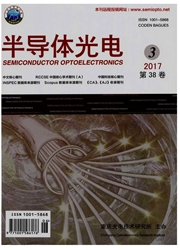

 中文摘要:
中文摘要:
针对a-Si∶H(n)/c-Si(p)双面异质结太阳电池结构,数值研究了不同p型单晶硅衬底厚度、氧缺陷密度、电阻率以及异质结界面缺陷态密度与电池转化效率之间的关系。结果表明:异质结界面缺陷态密度是影响电池性能的最主要因素,衬底前表面界面缺陷密度增大,主要降低开路电压和填充因子,衬底背表面界面缺陷态密度主要影响短路电流和填充因子。其次,p型硅衬底厚度减小和氧缺陷密度的增大,均导致短路电流密度下降,电池转化效率降低,特别是在界面缺陷态密度较低时,氧缺陷密度对电池性能影响较大;最后,在衬底前表面界面缺陷态密度为5×10^10cm^-2,后表面界面缺陷态密度为5×10^10cm^-2以及氧缺陷密度为10^9cm^-2时,衬底电阻率存在最优值1Ω.cm。
 英文摘要:
英文摘要:
Based on the structure of a-Si∶H/c-Si(p)heterojunction solar cell,the relationship of the cell efficiency with the thickness,the oxygen defect density,the resistivity and the defect density on the front and rear surface of the p-type c-Si wafer were investigated numerically by computer simulation.It is found that the defect density on the surface of the p-type c-Si wafer plays a crucial role to the performance of cells.And,the defect density on the front surface(Dit1)of the P-type wafer primarily affects the open-circuit voltage and the all factor(FF),while the defect density on the rear surface(Dit2)of p-type c-Si wafer mostly affects the short-circuit current density and FF.The short-circuit current decreases both with the decrease of the thickness of p-type c-Si wafers and the increase of the oxygen defect density,which will deeply decrease the cell efficicncy.The optimized substrate resistivity is about 1 Ω·cm when Dit1=5×1010 cm-3,Dit2=5×1010 cm-3,and Dod=109 cm-2.
 同期刊论文项目
同期刊论文项目
 同项目期刊论文
同项目期刊论文
 Fabrication of low-loss, single-mode-channel waveguide with DNA-CTMA biopolymer by multistep process
Fabrication of low-loss, single-mode-channel waveguide with DNA-CTMA biopolymer by multistep process Surface Plasmon Waves on Structured Metal Surface With Periodic Grooves Modified by Perpendicular Cu
Surface Plasmon Waves on Structured Metal Surface With Periodic Grooves Modified by Perpendicular Cu Orthogonal decomposition of elliptically polarized light through resonators composed of magnetic fil
Orthogonal decomposition of elliptically polarized light through resonators composed of magnetic fil Novel hybrid organic/inorganic 2D quasiperiodic PC: from diffraction pattern to vertical light extra
Novel hybrid organic/inorganic 2D quasiperiodic PC: from diffraction pattern to vertical light extra Theoretical and experimental study on transmission properties of THz wave in metal-coated hollow wav
Theoretical and experimental study on transmission properties of THz wave in metal-coated hollow wav Resonator with orthogonally polarized dual wavelength output based on layered anisotropic metamateri
Resonator with orthogonally polarized dual wavelength output based on layered anisotropic metamateri 期刊信息
期刊信息
